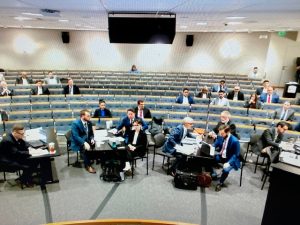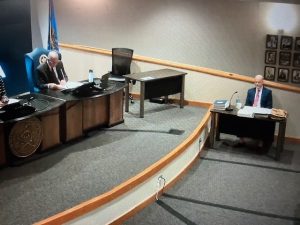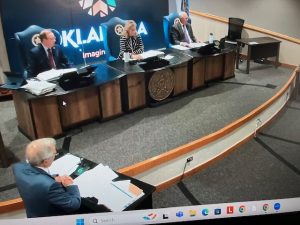
After two days of hearing legal challenges and claims regarding a request of Oklahoma Gas and Electric Company to pass along construction costs of natural gas-related projects, an Oklahoma Corporation Commission Administrative Law Judge and commissioners will sometime soon have decisions to make.
The costs are based on the controversial law stemming from SB998, a bill allowed to become law without the signature of Gov. Kevin Stitt. Adding to the controversy is how OGE went about asking for approval of millions of dollars in construction costs that could be added to the bills of its ratepayers who will have to wait several years to see any impact.
The utility initially filed a measure notifying the Corporation Commission in May of its intention to ask for a rate hike. But as soon as the legislature approved SB998, which paved the way for C-WIP or Construction Work in Progress costs directly involving natural gas energy, OGE withdrew its filing. It waited until the bill officially became law at the end of August before asking for approval to use SB998 and the cost recovery method known as CWIP.
Corporation Commissioners publicly opposed SB998 when it was proposed in the legislature but this week, endured two consecutive days of hearing testimony from witness after witness.

Kimber Shoop, Director of Regulatory Policy and Planning for OGE, spent the first three hours on Monday testifying in support of the request. OGE maintains that through the use of CWIP, it will save money for consumers.
The utility’s request has the support of Oklahoma Attorney General Gentner Drummond’s office as well as the Public Utility Division of the Corporation Commission. The Oklahoma Petroleum Alliance also has signed a stipulation agreement in support of the request.
But strongly opposing the request are the Oklahoma Industrial Energy Consumers and the Oklahoma Chapter of the AARP. Both contend the request by OGE is not applicable and is flawed.

Thomas Schroedter, President of OIEC, is also the organization’s attorney who steadfastly challenged OGE witnesses throughout the lengthy hearing. He also maintains the CWIP method will not be a cost-savings for OGE ratepayers. Further, he challenged the utility’s choice in bids for construction of two massive natural-gas generators for its Horseshoe Lake generating station, arguing the final choice was the 26th highest bid.
OGE stood by its use of CWIP and defended the process and also challenged the claims of higher cost made by the OIEC.
“It is demonstrated and shown in this proceeding that the inclusion and consideration of CWIP in rate base will not result in higher rates to the customer over the life of the plant constructed, but rather will decrease the Applicant’s total revenue requirements over such period and consequently lower rates. From the standpoint of the ultimate amounts of revenue required of the customers, the inclusion of CWIP in rate base cannot be said to be an overall detriment to such customers,” stated the utility in an early October filing.
Challenges were made. Some were upheld by the ALJ. Others were overruled. Finally, late Tuesday, Corporation Commission Chair Kim David closed the hearing with her statement, “It’s been a long day—-a couple of days.”
Now the case is in the hands of the ALJ and the Corporation Commissioners.

